…begins with a big honkin’ warping mill.
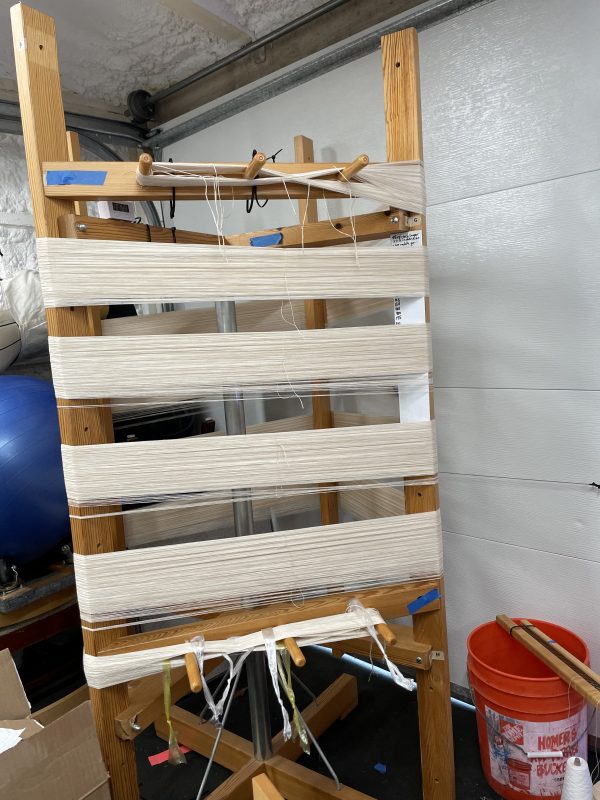
This is my three-meter circumference Glimakra warping mill, which is as-yet nameless (somehow only my looms seem to have enough personality to warrant names). In theory it’ll wind a 50-meter warp, though trying to wind 17 rounds around that warping mill seems like it would be rather fussy to me. As you can see, though, a 15-meter, 1,320-thread warp in fine threads is no problem!
I have two goals with these warps. The first is to reconfigure the arrangement of the jacquard looms. I’ve been going back and forth over how much to get into this, because explaining exactly what and how and why I’m doing what I’m doing involves quite a bit of technical discussion about how TC-2 jacquard looms work. The last few people I’ve tried to explain this to have gotten a glazed expression about 30 seconds into the discussion and discovered an urgent need to go clean their bellybutton lint after about 90 seconds, so I’m taking that as a sign that perhaps skipping that part of the discussion might be okay. 😉
Anyway, skipping the navel-scrubbing details, the first project is to reconfigure the jacquard looms, the end result of which is that I’ll eventually be able to weave easily at three different densities: 90 ends per inch, 60 ends per inch, and 30 ends per inch. This would be extremely useful to my weaving life, BUT in order to do that, I have to cut off the warps that are on both looms, swap the guts (heddles) of Grace into Maryam’s frame (still threaded), swap the guts of Maryam into Grace’s frame (still threaded), and add 880 more heddles to Grace.
Then, of course, I need to put warps onto both looms, to the tune of 4,400 threads. Whee!!
Grace is basically going to become my sampling loom. She is eventually going to have one 14.5″ wide warp threaded at 60 ends per inch, and one 29″ wide warp threaded at 30 ends per inch. I can do that because Grace is 43″ wide, with two warp beams. The idea is that I keep one side of the loom beamed and threaded at 60 ends per inch on one warp beam, and the other side of the loom beamed and threaded at 30 ends per inch on the other warp beam. The warp that is being woven goes through the reed, and the warp that is not being woven gets removed from the reed and tied off.
On a regular loom this would create all sorts of problems with the loom geometry, because regular looms are made out of wood and the uneven tension would warp the beams out of shape eventually (among many other things). However, I’ve been assured (by the manufacturer) that this isn’t an issue with the TC-2 jacquard looms, because the loom is made of heavy gauge steel and isn’t even going to notice any torsion from off-centered warps. (Those Norwegian engineers, they do not mess around!)
Most of my samples for classes are woven out of cotton, usually from 22-30 ends per inch. The advantage of weaving those samples on a jacquard loom, of course, is that I can sample many different drafts/woven patterns on the same warp, without having to rethread. Weave a simple twill? No problem! Switch out to overshot? Sure, why not? Weave an intricate, nonrepeating networked rosepath twill curvy something-or-other? Load ‘er up! I can even change the sett by leaving some threads unwoven, reducing the number of threads per inch.
More subtly, I can also weave complicated stripe patterns by threading up for double weave, one layer of Color A, one layer of Color B, and then selectively choosing which threads of Color A or Color B weave in the top layer. This means that, if I am threaded at 60 epi, I can weave whatever two-color stripe pattern I want at 30 epi on the jacquard loom without rethreading. So having a section of the jacquard loom dedicated to weaving at double-density makes a lot of sense for weaving samples.
So Grace’s setup will save me a HUGE amount of time and effort in weaving samples for my color classes. Without a jacquard loom, I’d have to rethread every time I wanted to sample a new weave structure, and rewarp every time I wanted to try a new stripe combination. That would make creating samples prohibitively expensive. Grace will let me create the samples I need in a timely and efficient manner.
Maryam, on the other hand, is going to switch out with Grace and become my loom for artistic weavings. Grace is currently threaded at 90 ends per inch, 29″ wide, and I’m swapping that configuration into Maryam.
So what, exactly, is going onto the looms?
The warp that’s going onto Grace is destined to be samples for an upcoming class about designing with color gradients. (Coming this fall!) I want to get 72 samples off that warp – there will be 3 samples across and 24 different samples along the length of the warp. I want to get a LOT of different color combinations, so rather than put on a bazillion warps, I’m splitting the warp into three bouts and painting each bout with a different sequence of colors corresponding to the color samples I want to make. I tied off each bout at carefully marked intervals so the color changes would be synchronized across all three warp bouts once the warps were on the loom. That way I can do three samples across, each with a different set of colors, using the same weft. Because the color changes are synchronized, each set of samples will start and end in the same place, color-wise, so I won’t wind up with any half-samples or overlaps.
Sounds complicated, but it’s really not that complicated.
But – ha ha! – that’s not actually what I’m doing. Because why do anything the moderately complicated way when you can do it the even more complicated way??
I mentioned earlier that, on a jacquard loom, if you set up your warp at double density, with one “layer” of warp in one color, and one “layer” of warp in another color, you can do arbitrary stripe patterns by picking which threads of which color weave into the top layer. And I’m doing a class on color gradients, so I need to weave samples that show the different kinds of color gradients you can create by alternating threads. For example, you can do a linear gradient, like this:
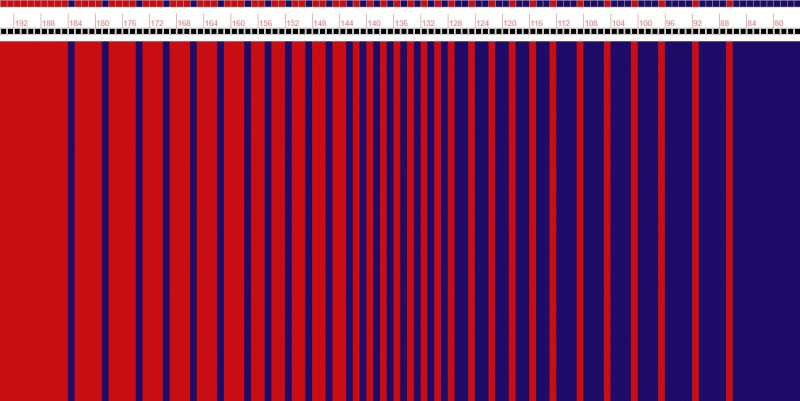
Or you could alternate threads to give the illusion of curvature, like this:
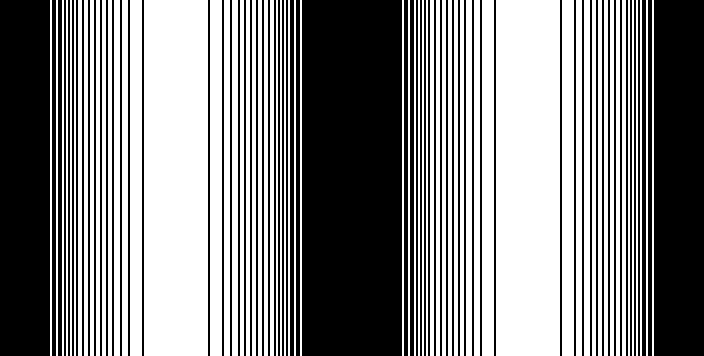
So what I’m ACTUALLY doing is winding six bouts of painted warps, painting them so the colors synchronize three bouts wide across the warp and two layers deep. Then I’m going to interleave them to get a lot of color combinations, and then weave samples that show different possibilities of stripe patterns combining the different color combinations.
Oh, and I’m also demonstrating the effects of different weft colors, setts, and weave structures, too, in combination with all of the above.
You can see that 72 samples, while a seemingly large number, is actually quite a small number, not nearly enough to explore all the possibilities. If I were exploring at random, I’d throw up my hands completely.
Fortunately, I’m not exploring at random. At this point I have a very good understanding of What Goes Down with color in weaving, so I can pretty well predict what happens when you do X with Y under conditions A, B, and C. So I think I can make 72 samples cover MOST of what I want to illustrate. A few samples and some finished pieces will have to be woven on the Ruth, my Baby Wolf loom. (As powerful as Grace and Maryam are, there are some things that jacquard looms don’t do well. For those things, well, Ruth to the rescue!!)
Next, there’s Maryam. Maryam is getting the “art” warp.
I haven’t really had time to plan out the art project. I’ve shelved Tourmaline Butterfly for now, basically on the grounds that it is going to take more time and effort than I can realistically expect to have available. I need to put on a warp that I can produce small projects on in spare moments – which, for me, means a project that “only” takes a month or so and maybe 40-100 hours to complete. (Moderation, after all, is best done in extreme moderation. 😉 ) I also need a warp that is attractive and interesting enough to seduce me away from working on the teaching business nonstop, which is a tall order most days. And I need a warp that is flexible enough that I can produce both more conservative pieces and caution-to-the-wind pieces on it.
So I think what I’m going to do is put a double weave warp onto the loom, two layers at 45 ends per inch, and make one layer plain black 20/2 cotton at 45 ends per inch, and the other a wild-woman warp, four strands of different yarns randomly dyed in shades of brilliant orange, red, gold, and yellow. My theory is that since it’s double weave, if I want a boring, conservative warp on which I can weave just about anything, I can use the black warp on the surface and bury the orange warp on the back. If I want to go hog-wild, I can weave the orange warp on the surface. And of course, I can do layer interchange and do really cool stuff with the black warp alternating with the orange warp in areas. Monarch butterfly? Tiger? YES PLEASE!!
Why orange-red-yellow-gold? Because (as a quick look at either my work or my wardrobe will tell you) brilliant orange is my favorite color, and if I want a warp that will lure me to work on it, bright orange tie-dye is definitely the way to go.
I liked the textured effect of the warp I put on for Bipolar Prison, which was one strand of 10/2 unmercerized cotton, two strands of 16/2 mercerized cotton, and one strand of 30/2 silk. It was randomly dyed, and because the different fibers took up the dyes differently, and the yarns were of different sizes, the resulting cloth had a wonderfully textured look to it:
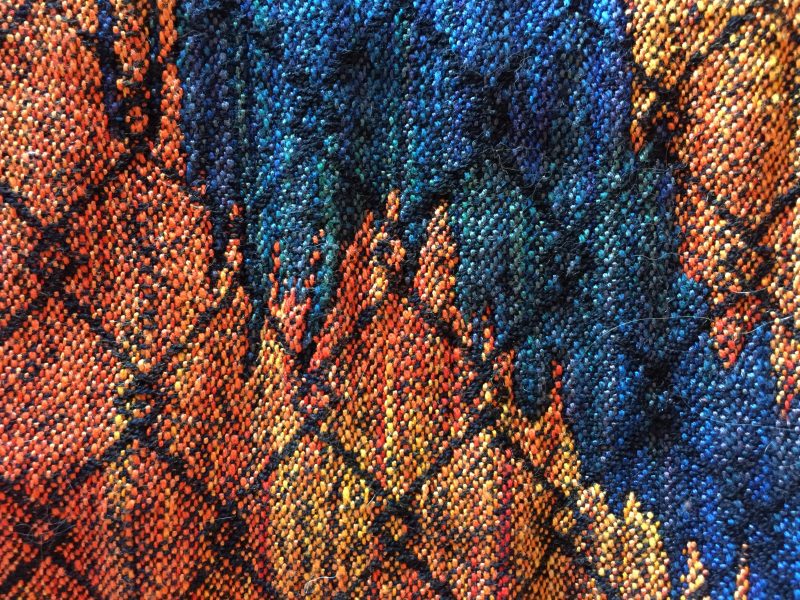
The unmercerized cotton shed lint that created little fuzzy rings around each warp thread, so I won’t be using that again.
Instead, for this warp, I’ve wound one strand of 10/2 natural mercerized cotton (4200 ypp), one strand of bleached white mercerized 20/2 cotton (8400 ypp), one strand of fine 4-ply silk cord (8400 ypp), and one strand of 60/2 silk (15,000 yards per pound). Here they are:
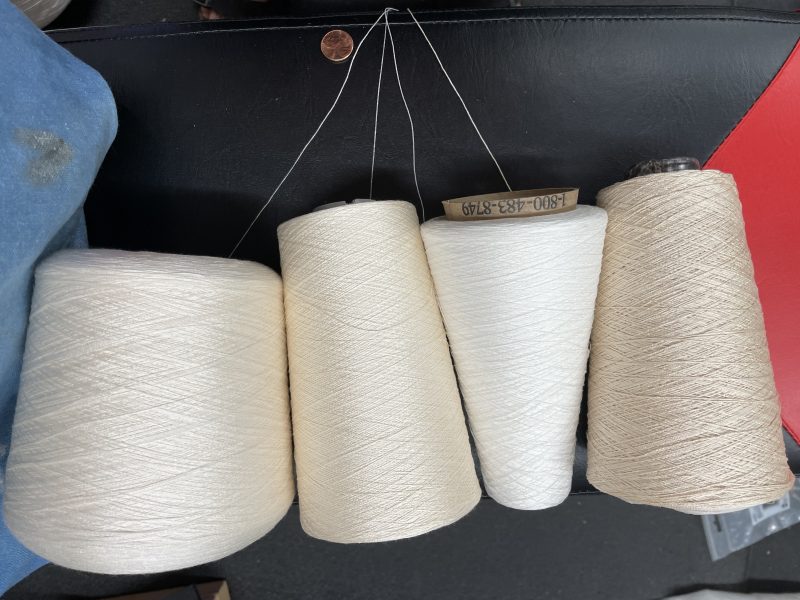
I wound the threads in a 4×4 cross, holding the threads between my fingers, and plan to thread them in random order to give more texture to the fabric. Will that be a dreadful mistake? Only one way to find out!
Anyway, here is where the Journey of 4,400 Warp Threads currently stands:
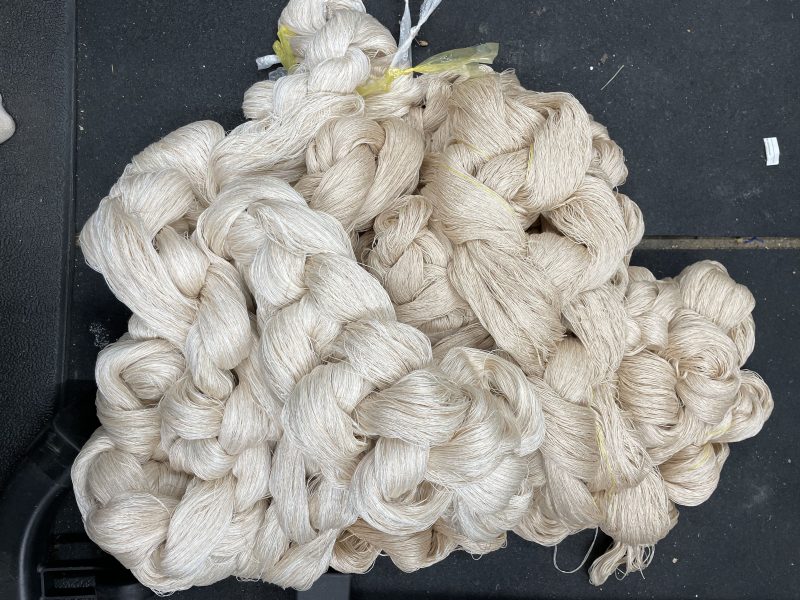
I have wound the entire warp for Grace, and half the warp for Maryam, so the current warp thread count is 3,136 (I always wind a few extras when winding painted warps, for fixing broken threads). I’m now at the point where I can start painting the warps. (The remaining warp to be wound is the layer of black warp for Maryam.) Unfortunately, the table on which I would have painted the warp has been removed since we cleared out the back yard yesterday, and the new table hasn’t been purchased/delivered yet, so warp-painting will have to wait, perhaps until early next week.
I guess I will have to settle for giving Fritz a belly rub. Here he is, practicing cat yoga while waiting:
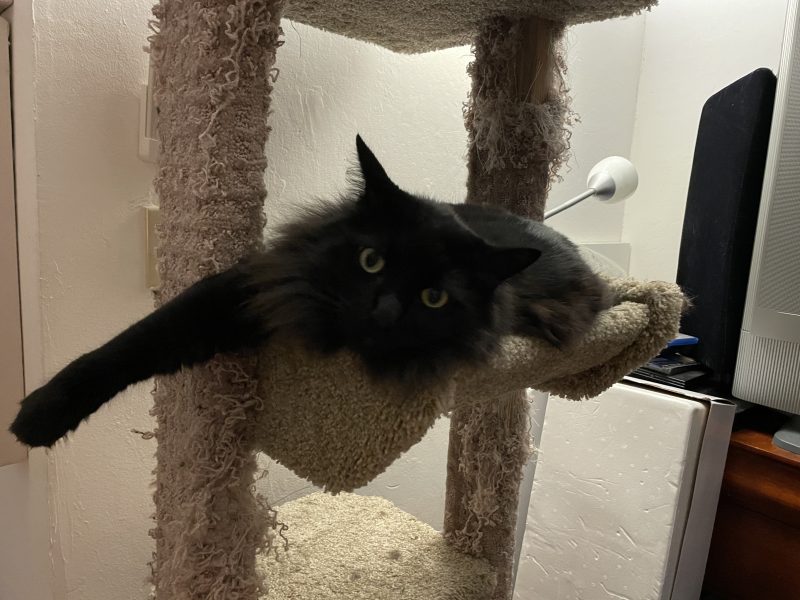

Tien
Thanks for this detailed and fascinating description of your work. The versatility of the TC2 jacquard looms is amazing and now I have a glimpse of how it works. I was astounded by your descriptions of working with two warps on one loom, changing the sett by eliminating thread use, and adding and subtracting stripes. ( I was also somewhat astounded that I could actually understand the concepts without resorting to navel gazing! Though admittedly, that could occur if you began describing the mechanical workings☺️). Best wishes , Deborah
Your posts are wonderful!! I truly enjoy them. I am a much more simple minded weaver but your descriptions of your work are so admirable. Not to mention, your weaving and work are gorgeous!! Thank you for sharing and enriching my weaving experiences.